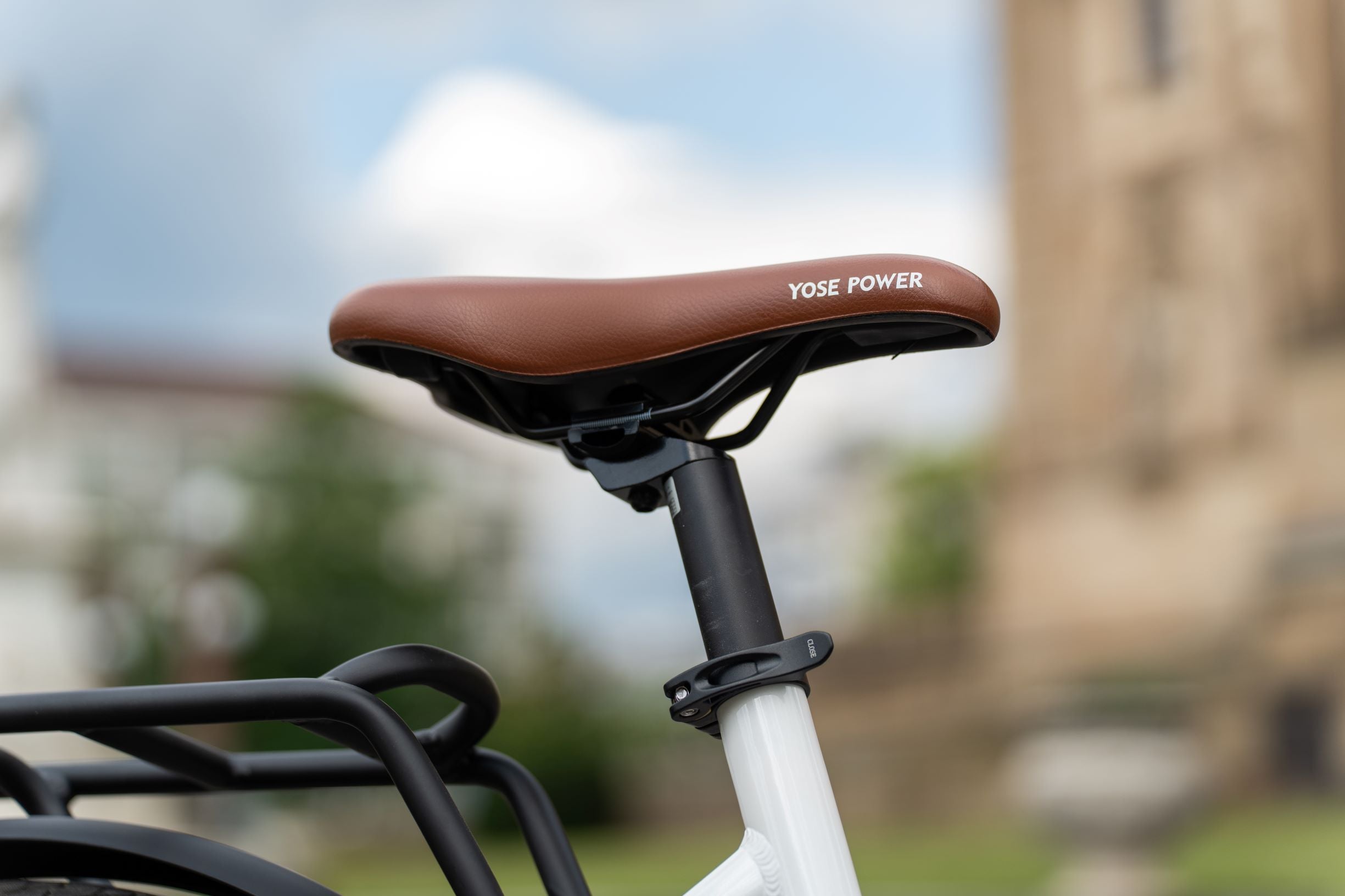During cycling, your sitting posture on the bicycle is crucial for overall comfort, and it is closely tied to individual characteristics. Adjusting a bicycle posture that suits you involves a multitude of factors, including body measurements and adjustable dimensions on the bike. Additionally, one must consider the sensations during cycling and possible discomfort. Ensuring harmony between your posture and the type of bicycle you are using is a fundamental prerequisite for enjoying the pleasure of cycling. Read on here to understand how to achieve a more harmonious unity between yourself and the bicycle during your rides.
How to get the best seating position on a ride?
Whether you're riding a road bike, mountain bike, or any other type of bicycle, the correct saddle position is crucial to ensuring comfort, enhancing efficiency, and preventing injuries. It depends not only on factors such as height, leg length, and flexibility but is also intimately connected to individual experience. If you feel discomfort or experience pain while cycling, it could be a result of improper posture. Symptoms such as neck or back pain, knee or wrist discomfort, numbness in fingers or feet, could all be signals of seating position issues.
Adjusting the saddle height and handlebars of your bicycle is a fundamental step in ensuring comfortable and efficient cycling. Particularly for road bikes, the correct saddle height is crucial for pedal efficiency and posture. Utilize a dedicated bicycle saddle height chart to calculate the appropriate saddle height, ensuring your legs are slightly bent during pedaling to avoid undue strain. Additionally, raising the handlebars contributes to achieving an ergonomic and comfortable seating position. These adjustments are essential for ensuring the long-term comfort and performance of your bicycle. Even if you currently experience no discomfort while cycling, checking and adjusting the seat position remains a worthwhile consideration.
What is Ergonomics?
Ergonomics is the science that studies how bicycles and their components adapt to the rider's body characteristics, aiming to achieve maximum efficiency, comfort, and safety. In cycling, an ergonomic saddle position not only prevents fatigue and pain but also enhances the joy of riding.
Proper Adjustment of Saddle Height
When adjusting the bicycle saddle, ensuring the correct height is a key step to guarantee comfortable and efficient cycling. Whether on a road bike or a city bike, the principles of saddle adjustment are similar. Firstly, it is essential to ensure the height of the saddle is adjusted properly, allowing for a slight bend in the legs during pedaling to avoid overloading the knees. Saddle adjustment also involves tilting and horizontal positioning. A correctly adjusted saddle provides optimal support for the seating position, especially crucial for road bikes. Taking the time to adjust the saddle correctly is crucial, as it significantly impacts both the efficiency of cycling and the comfort of the ride. Many cyclists tend to set the saddle too low for a better ground contact, believing it enhances the feeling of safety.
Determining Bicycle Saddle Height – Various Methods
- “Heel”Method:
This simple tool-free method for adjusting saddle height involves the following steps:
- Sit on your bicycle.
- Rotate one pedal to its lowest point.
- Place your heel on the pedal.
*Important Note: If your knee is slightly bent when your leg is fully extended, you have found the ideal saddle height. If your leg is completely extended, the saddle is too high. If your knee is noticeably bent, the saddle is too low.
- 1.09 Method
This method, reportedly introduced by Hamley and Thomas in the 1960s and popular among American professional cyclists in the 1970s, is as follows:
- Remove your shoes and stand against a wall with your back.
- Separate your feet, pointing your toes straight ahead, and align the outer edges of your feet with the width of your shoulders. This simulates the horizontal distance between your feet on the pedals while riding. Strive to align the hip joint, knee joint, and ankle joint in a line approximately perpendicular to the ground.
- Find a book that is 3cm thick to simulate the saddle and saddle nose. Place it between your legs, with the spine against your perineum. Apply upward force, ensuring the lower edge of the book touches the wall. Record the height of the spine, measure it; this is your inseam height. (Inseam height is essential when selecting a frame and is a fundamental measurement to be aware of before cycling.)
- Multiply the inseam height by 1.09, and the resulting length is the distance from the crankshaft axis to the farthest end of the saddle.
- Lemond Method
This method was proposed by Greg Lemond and his coach Cyrille Guimard. The specific procedure is as follows:
Multiply the inseam height by 0.883, and the resulting length is the distance from the bottom bracket to the saddle. There are also variations suggesting multiplication by 0.885 or, after the latest revision, by 0.887.
The accuracy of both the Lemond method and the 1.09 method is a subject of debate. This is because neither of these methods involves being on the bicycle, excluding factors related to the saddle. In reality, several saddle characteristics can impact actual saddle height, including firmness, width, curvature, horizontal angle. By not being on the bike, factors such as riding posture (pelvic angle, actual sitting position) are not taken into account. Additionally, the thickness of the pedals varies, affecting the actual height where the feet make contact. Therefore, these two methods can only serve as rough guidelines and require fine-tuning based on individual experiences and personal sensations.
- Holmes Method
The Holmes method, predating the emergence of dynamic fitting, was one of the most professional approaches and widely used by coaches in professional cycling teams at the time. The operational process of the Holmes method best reflects the principles of saddle adjustment.
There are various interpretations of the specific procedure, with minor differences, primarily focusing on angular variations. Below is the road bike saddle height setting method as outlined by Phil Burt, the Team Sky Consultant Physiotherapist, in the book "Bike fit"

In a normal sitting position on the bike, hands on the handlebars, and pedals at the bottom. The angle of the knee joint, the angle formed by the thigh and the calf, should be between 140 and 145 degrees. Adjust the saddle height to ensure the knee joint angle falls within this range, indicating an appropriate saddle height.
The horizontal placement of your saddle's setback
- Knee Over Pedal Spindle (KOPS):
KOPS is the current mainstream method for determining the fore-aft position of the saddle:
- Sit on the bicycle with the pedals positioned horizontally.
- Place a plumb line over the knee of the forward leg.
- The vertical line should ideally "intersect" the pedal spindle. If it is too far forward, adjust the saddle backward. If the line is too far back, move the saddle forward.
Whether this method is reasonable is a subject of varying opinions among different fitters. For instance, Steve Hogg disagrees and has proposed his own approach.
- Steve Hogg Method
Steve Hogg's approach involves a comprehensive consideration of factors such as effective torso length, pedaling capacity (lower limb muscle strength), and individual body functionality (core muscle strength, muscle and ligament flexibility) when determining the fore-aft position of the saddle. In practical terms, the cyclist is positioned on a stationary bike with resistance set to time trial intensity, for example, reaching 85% of the individual's maximum heart rate, maintaining a cadence of 95-105. With hands gripping the handlebars at full power output, and maintaining a stable pedaling state, the rider gradually moves hands backward from the handlebars while attempting to retain the original pedaling posture. Despite the torso swaying with the pedal strokes, the rider should be able to sustain this position without losing balance, arching the back, standing upright, or leaning forward.
The concept of "effective torso length" is understood by the author as the actual torso length during cycling. For individuals with a longer upper body, if they excessively bend their waist or arch their back while riding, or if their upper body remains relatively upright without bending, the effective torso length becomes shorter. Conversely, for individuals with a shorter upper body, maintaining a relatively straight back by pivoting at the hips and leaning forward allows for a longer effective torso length. In essence, the effective torso length is closely related to muscle strength and ligament flexibility. For a more detailed explanation, refer to Steve Hogg's original article "Seat set back: for road bikes".


Share:
The 7 Secrets to Master Rainy Day E-Biking
What Do We Need to Pay Attention to When Decorating E-Bikes?